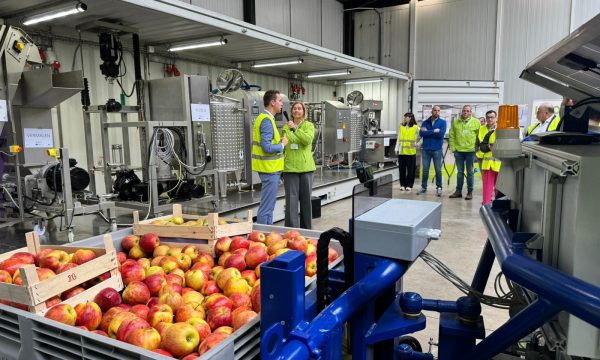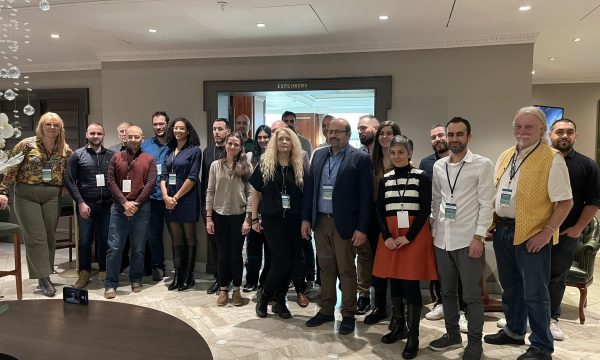Press release Future high-value applications for tomato surpluses and Belgian Endive roots

"By-products from the horticultural sector are still chock-full of useful substances, but the trick is to use them in the right way. That is, to derive a useful and stable product that can be used in various sectors such as the food sector or crop protection," says ILVO-UGent researcher Lies Kips. She investigated a number of possibilities for valorizing surplus tomatoes and Belgian endive roots.
Tomatoes and Belgian endive roots
For the processing of soft textures such as tomatoes, the spiral filter press proved to be ideally suited. This pressing method results in a stable and high-quality juice, and in a dry residual fraction rich in health-promoting phenolic components and carotenoids. With Belgian endive roots, the bitter substances, phenolic components and minerals present in particular proved promising for further valorization.
Circular economy: from theory to practice
In the circular economy, we deal more efficiently with raw materials, materials, energy, water, space and food by closing cycles in a smart way. Natural resources are reused as much as possible. In the horticultural sector this means, among other things, the efficient valorization of by-products. Flemish success stories in that sector include the development of leek powder from leek greens, or the development of pear juice to process harvest surpluses. Each story has its own specific challenges, but in general we can distinguish three major challenges:
1) Horticultural by-products from different crops arise in various forms through different stages in the supply chain. For example, in fruit cultivation leafy greens and wood are available, but also fruits that do not meet color and/or shape requirements.
2) Their composition indicates their potential to be valorized in various industries. Usually, by-products contain a lot of useful substances, such as vitamins, minerals and fibers. However, detailed knowledge about the composition of locally available by-products and the variability in that composition is often lacking.
3) They are characterized by a number of properties that prevent their practical valorization, such as a high moisture content (risk of decay), scattered and seasonal availability, difficult collection and lack of purity.
In other words, the food sector is looking for products with an interesting composition that can be well preserved. Moreover, they would like a predictable and logistically feasible supply. ILVO-UGent researcher Lies Kips took up the challenge for two specific, but completely different residual flows: surplus tomatoes at the auction and forced Belgian endive roots that remain after harvesting the leafy heads.
From surplus tomatoes to high-value tomato juice
Verse tomaten hebben een zeer beperkte houdbaarheid, dus de eerste stap naar valorisatie is stabilisatie van het product. Tijdens piekmomenten in het productieseizoen is er jaarlijks een overproductie zo’n 3000-6000 ton tomaten die niet tot bij de consument raken. Lies Kips onderzocht de mogelijkheid om de innovatieve spiraalfilterpers te gebruiken om deze tomaten te verwerken. Hierbij ontstaan er twee stabiele fracties: het sap als vloeibare fractie en het persresidu als vaste fractie. Deze perstechnologie heeft namelijk twee belangrijke voordelen: ze is heel breed inzetbaar waardoor ze kan gebruikt worden om verschillende types en hoeveelheden van reststromen te verwerken, en de natuurlijkheid van het product qua kleur, samenstelling en smaak wordt optimaal bewaard. Het persproces van de tomaten werd geoptimaliseerd naar opbrengst met behoud van kwaliteit door onder andere het verhogen van de spiraalfrequentie en het vergroten van de zeefporiën. Eindresultaat was een zeer efficiënt proces met enerzijds een tomatensap (97 % rendement), en anderzijds een persresidu dat enkel nog bestaat uit tomatenpitten en -schillen.
Op basis van de proeven bleek het tomatensap zeer stabiel (>100 dagen), maar wanneer exact dezelfde procescondities gebruikt werden op een andere variëteit, werd het sap onstabiel. De kunst bij het gebruik van de spiraalfilterpers bestaat er dus in om de flexibiliteit van het systeem optimaal te benutten zodat voor elke grondstof een optimaal resultaat wordt bekomen door het aanpassen van de cruciale procesparameters.
Wat betreft de samenstelling van het sap, werden de verwachtingen van de spiraalfilterpers volledig ingelost: de procesimpact bleek zeer beperkt op de belangrijkste gezondheidsbevorderende stoffen, zoals vitamine C, fenolische componenten en carotenoïden. Vooral het persresidu bleek aangerijkt aan fenolische componenten (gemiddeld 5 keer) en carotenoïden (gemiddeld 2,5 keer) in vergelijking met het niet-gepasteuriseerde sap. Bij het tomatensap bleek de concentratie aan carotenoïden echter significant af te nemen na een thermische behandeling. Verder onderzoek zou dus moeten focussen op (i) het koppelen van de spiraalfilterpers met alternatieve, innovatieve en milde technologieën alsook (ii) de valorisatie van het persresidu, gezien de aanrijking van de onderzochte componenten.
Fresh tomatoes have a very limited shelf life, so the first step to valorization is to stabilize the product. At peak times in the production season, there is an annual overproduction about 3000-6000 tons of tomatoes that do not reach the consumer. Lies Kips investigated the possibility of using the innovative spiral filter press to process these tomatoes. This creates two stable fractions: the juice as a liquid fraction and the press residue as a solid fraction. This pressing technology has two important advantages: it is very versatile, so it can be used to process different types and quantities of by-products, and the naturalness of the product in terms of color, composition and taste is optimally preserved. The tomato pressing process was optimized for yield while maintaining quality by, among other things, increasing the spiral frequency and enlarging the sieve pores. The end result was a very efficient process with a tomato juice (97% yield) and a press cake consisting only of tomato seeds and peels.
Based on the tests, the tomato juice proved to be very stable (>100 days), but when the exact same process conditions were used on a different variety, the juice became unstable. Thus, the art in using the spiral filter press is to make the best use of the flexibility of the system so that an optimal result is obtained for each raw material by adjusting the crucial process parameters.
Regarding the composition of the juice, the expectations of the spiral filter press were fully met: there was only a very limited processing impact on the main health-promoting substances, such as vitamin C, phenolic components and carotenoids. Especially the press residue was found to be enriched in phenolic components (average 5 times) and carotenoids (average 2.5 times) compared to the unpasteurized juice. However, in the tomato juice, the concentration of carotenoids was found to decrease significantly after thermal treatment. Further research should therefore focus on (i) the coupling of the spiral filter press with alternative, innovative and mild technologies as well as (ii) the valorization of the press residue, given the enrichment of the components studied.
Belgian endive roots as a raw material
Some 40,000 tons of chicory are produced annually in Belgium, a crop that simultaneously produces 36,000 tons of forced roots as a by-product. Today, this root mainly ends up as fodder in cattle stables, a use that, according to the principles of the circular economy, delivers too little value. But do these forced chicory roots still contain valuable substances, and if so, what are they? In a second line of research, Lies Kips analyzed chicory roots for occurrence and concentrations of bitter substances (sequiterpene lactones), phenolic components, minerals and antioxidant capacity . She came to the conclusion that the roots indeed contain a mass of bitter substances and phenolic components, mostly in higher concentration compared to the actual chicory head. These offer potential for the use of the root in various sectors such as the food and pharmaceutical industries, or as a biocide or biostimulant in vegetable production. Furthermore, the roots contain sufficient minerals Fe and Cu to justify a nutritional claim 'source of' on the packaging. The presence of the demonstrated substances offers perspectives for a successful valorization towards a bioactive extract rich in bitter substances and phenolic components. Before industrial valorization can be realized, however, a number of steps still need to be taken, including research into the activity, stability and toxicity of the substances, and into the upscaling of the extraction method.


